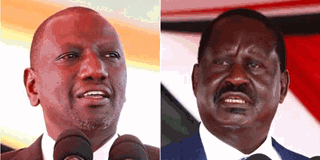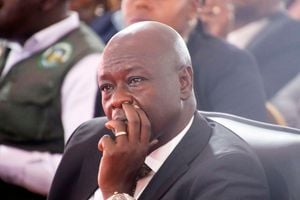We need a Fairness Doctrine in TV coverage of presidential candidates

Deputy President William Ruto and ODM leader Raila Odinga.
What you need to know:
- TV coverage is critical in political campaigns.
- It’s important to regulate TV coverage of campaigns for fairness.
We need the old American-style Fairness Doctrine and its corollary, quasi-equal airtime exposure, particularly for presidential candidates. If, say, NTV or Citizen sold, or gave free, airtime to one candidate, it would be obligated to provide the opposing candidate with the same opportunity. If NTV or Citizen presented a programme attacking one candidate, it would be obligated to provide the attacked candidate an opportunity to reply.
We already have an aspect of this rule. “The Code of Conduct for the Practice of Journalism in Kenya” requires the media to publish fair, accurate and an unbiased stories on matters of public interest and cover all sides of a story. They are also required to seek comments from anyone who is mentioned in an unfavourable context. But the Code does not go as far as the Fairness Doctrine.
There is one thing, however, even the American-style Fairness Doctrine would be unable to regulate — which candidate is placed first in the news bulletin. Although editors have a professional criteria which they use to decide where to place each story, they can be influenced by other factors.
The Fairness Doctrine required broadcasters to present fair and balanced coverage of controversial issues of interest to communities. It provided “a basic standard of fairness” in broadcasting and encouraged the use of television and radio in the public interest.
Homegrown Fairness Doctrine
The rationale behind the Fairness Doctrine was simple. Broadcasters use radio frequencies (airwaves), a publicly owned resource to which they have the privileged access. As a quid pro quo, they must serve the public interest. The same argument can be made in Kenya. Our broadcasters use the spectrum, a public resource; they owe it to the public to use it responsibly and in the public interest.
For over 50 years, from 1934 to 1987, the US Federal Communications Commission (FCC) — the equivalent of the Communications Authority of Kenya (CA), which regulates the use of our airwaves — was guided by the Fairness Doctrine. In 1987, it repealed most of the Fairness Doctrine and, by 2011, all of its provisions had died away. The FCC argued that the doctrine was no longer necessary. But the equal-time rule is still in place.
A homegrown Fairness Doctrine would be particularly useful in guiding the coverage of presidential campaigns. TV is visual. It lends itself well to the coverage of political campaigns because of the optics, including crowd sizes, which are important for showing popularity. Candidates try to get large and responsive crowds for TV coverage to give the impression that they are popular and to influence undecided voters.
This week, a Nation/NTV investigation demonstrated just how far candidates will go to get crowds (“Crowds for hire”, Daily Nation, March 21, 2022). Candidates will do anything, including hiring crowds and using photo and video editing software, to distort rally numbers, according to the investigation.
TV coverage of campaigns
TV coverage is critical in political campaigns. The Media Council of Kenya’s “State of the Media 2021” states that 69 per cent of Kenyans interviewed trust TV, which is also the main source of news for 35 per cent of those interviewed (as opposed to 31 per cent for radio). Some 16.7 million Kenyans aged over 15 consume TV content on a typical day.
It’s important, therefore, to regulate TV coverage of campaigns for fairness. This does not require new legislation. The Kenya Information and Communication Act has enough provisions to enable the CA, established by the Act, to usher in a Fairness Doctrine.
The Act requires broadcasters to facilitate, promote and maintain a diversity and plurality of views. The law also allows the Minister to require broadcasters to provide content that promotes the public interest. It requires broadcasters to present news and information accurately and impartially. When contentious issues of public interest are discussed, broadcasters must make reasonable efforts to present alternative points of view.
The functions of the CA include developing media standards and regulating and monitoring compliance with those standards. It can borrow from the American experience. It has the power to introduce a Kenya-style Fairness Doctrine. There could not be a better time to do this than today.
The Public Editor is an independent news ombudsman who handles readers’ complaints on editorial matters including accuracy and journalistic standards. Email: [email protected]. Call or text 0721989264





